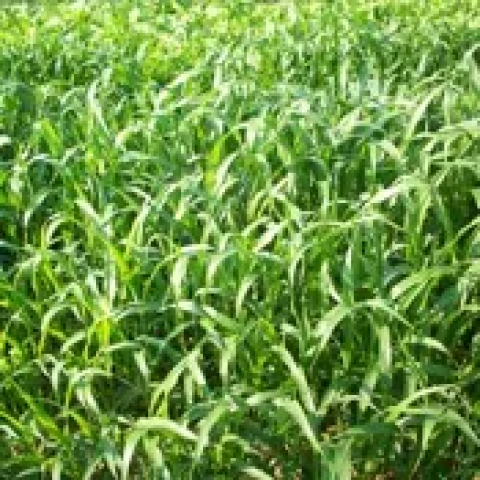Sudangrass

Sudangrass and sorghum-sudangrass
Sudangrass and sorghum-sudangrass are midsummer grasses suitable for short, 8-10 week plantings. Sorghum-sudangrass is often referred to generically as Sudex, although that is DeKalb’s trademarked name. These grasses are the most heat- and drought-tolerant cover crops used in the Northeast. Sudangrass growth is easier to manage because the stems are narrower. It can be sown earlier than sorghum-sudangrass and suppresses weeds better if densely sown. These crops provide abundant root biomass, which is useful for increasing soil organic matter. Mowing encourages root growth. Some varieties suppress root-knot nematodes.
Land Preparation
Prepare a clod-free seedbed. Avoid hard soil and wet spots. Do not plant just before a heavy rain.
Seeding Rate
30 lb/ac for biomass and nematode control. 50 lb/ac for weed control. Seed size varies widely, so if using a variety with larger or smaller seed size than average, adjust the rate to provide a similar plant population.
Seed Cost
2024 cost: $1.60/lb
Seeding Dates
June through mid-August (sudangrass). July through mid August (sorghum-sudangrass). These cover crops require warm soil to germinate.
Time Until Control
Five to six weeks to first mowing (30 inches), then allow regrowth for 4-5 more weeks.
Seed Suppliers
Albert Lea Seedhouse, Seedway, UAP, local farm seed dealers. To suppress nematodes, use a variety that is high in dhurrin (such as Trudan8, Sordan 79, Green Grazer V, and Special Effort). See the section on root knot nematode.
Management Tricks
Needs hot weather. Often needs to be mowed. To suppress nematodes, use a variety (such as Trudan8) that is high in dhurrin, not forage varieties.
Unavoidable Problems
Big crowns decompose slowly, so it is difficult to prepare a seedbed for small-seeded crops immediately after sudangrass.
Avoidable Problems
Provide up to 50 lb/ac nitrogen if there is little residual N in soil.
Classic Uses
Good summer cover with lots of biomass. Usually followed by a winter grain cover crop. If there is not enough time to use sudangrass, use buckwheat.
Maintenance
Mow when 20-30 inches tall, leaving a 6 inch stubble for regrowth. Leave residue uniformly on the soil surface for weed suppression. Timely mowing is important because tall, fibrous plants are difficult to mow or incorporate.
Control
Big crowns decompose slowly, making it difficult to prepare a seedbed for small-seeded crops. Incorporate sudangrass if planting something else in the fall. Otherwise, mow for winter-killed mulch on the surface and till in early spring. Tall, unmowed sudangrass will winterkill, but is difficult to manage in the spring.
Tips
Good summer cover if a long mid-summer period is available. Usually followed by a winter grain cover crop. For shorter summer opportunities, use buckwheat. Add nitrogen fertilizer if there is not substantial residual after the previous crop. This plant can be used in some insectary mixes because sorghum may harbor greenbug (Schizaphis graminum), which in turn attracts ladybeetles, lacewings, and other beneficial predatory insects.
| Management Goal | Planting Time |
|---|---|
| Attract Beneficial Insects | Summer |
| Increase Organic Matter | Summer |
| Reduce Surface Hardness | Summer |
| Suppress Nematodes | Summer |
